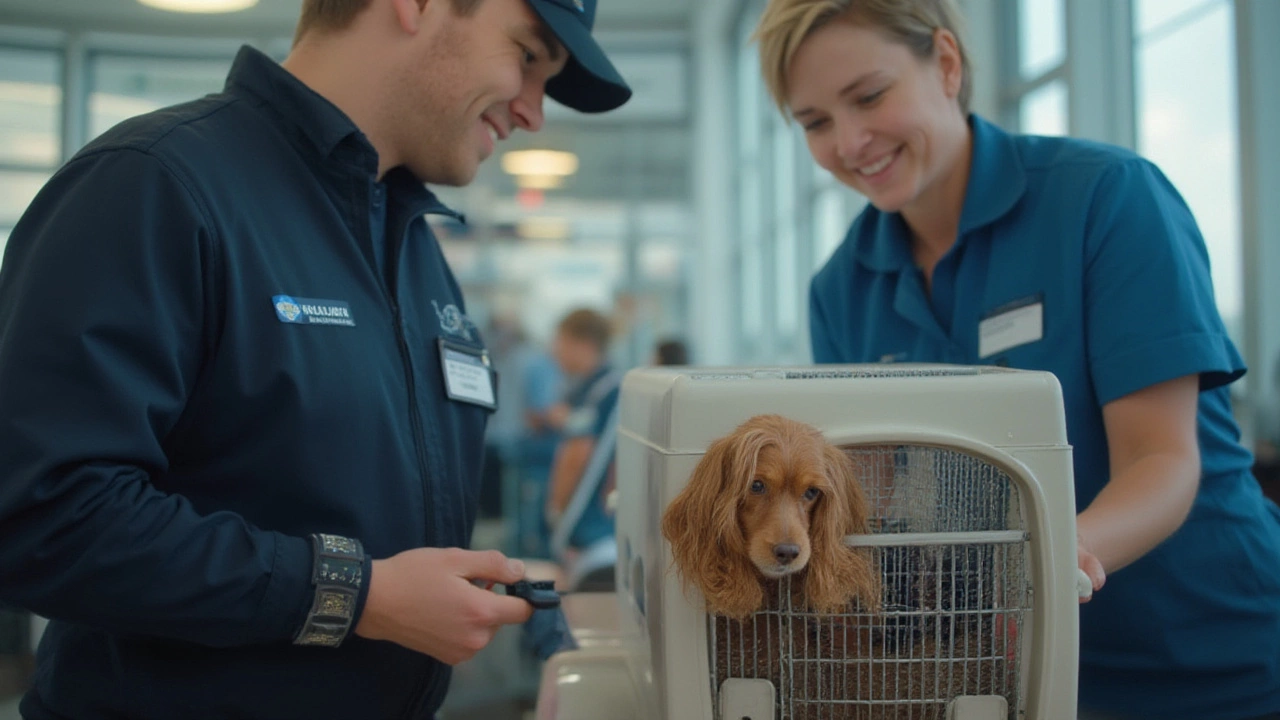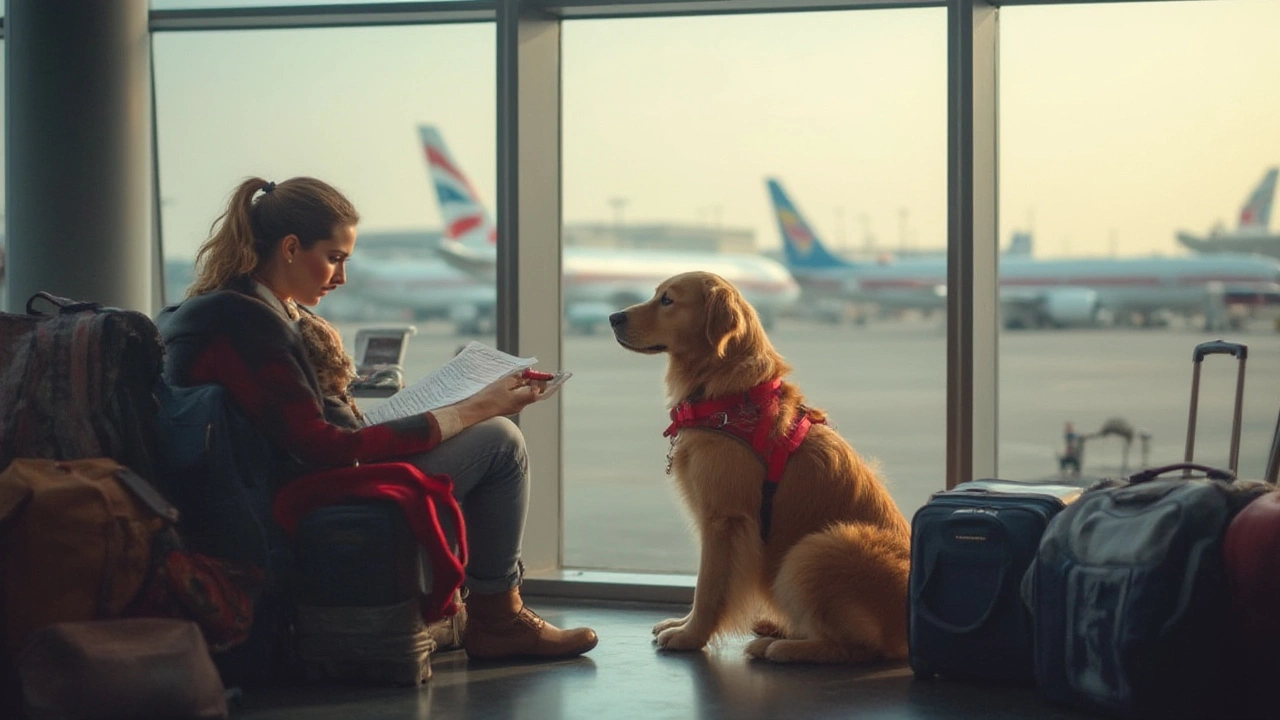Picture this: you're at the airport, suitcase in one hand, your dog's leash in the other. Ever wonder what actually happens between check-in and when your pup wags his tail at your destination? Curiosity about dog air travel is natural, and it's not as mysterious as it seems (though there's plenty happening behind those closed doors).
Behind the Terminal Doors: What Really Happens
So your flight is at noon, and you’ve just checked in with your dog. Depending on size and airline policies, dogs fly in-cabin, as checked baggage, or via special pet cargo. Surprisingly, about two million animals fly on airplanes each year, and the majority arrive safely thanks to strict handling protocols. If your dog is too large for the cabin (usually more than 20 pounds or too tall for the under-seat carrier), he’ll be ticketed as live animal cargo — sounds scary, but it’s actually a highly regulated, closely monitored process.
The journey begins at check-in. Cargo staff carefully attach custom travel crates with sturdy identification. Not just any crate makes the cut—airlines require that they meet International Air Transport Association (IATA) standards, which means a secure door, solid construction, and enough space for standing, turning, and lying down. Ventilation on at least two sides is a must, and absorbent bedding is required (airlines do check). Airline staff place brightly colored “Live Animal” stickers on all sides of the crate, plus labels for orientation (“This End Up”), range of temperature tolerance, and detailed owner contact info.
Before your pet even leaves the check-in desk, trained airline personnel do a final wellness check. They’ll look for signs of stress or illness—airlines actually refuse animals that show obvious distress. Once cleared, your pup (with or without a quick goodbye lick) disappears into the secured loading area. Here, handlers trained in animal welfare take over, working in small teams. They never stack crates, and each dog gets carried or wheeled gently to the loading zone. Vet-approved temperature and pressure controls are double-checked before your dog’s crate is ever loaded on board.
What you may not see: at most airports, dog crates pass through dedicated animal checkpoints with less noise and bright light than regular baggage handling areas. Teams use noise-dampening headsets, and handlers sometimes talk to nervous dogs speaking softly. The stats back up this caution—according to the U.S. Department of Transportation’s 2024 report, pet incidents on planes fell to less than 0.02% of a million flown animals that year.
Right before boarding begins for humans, the animal holding area coordinates directly with ground and cabin crew. Timing really matters because the goal is to load dogs last, so they spend as little time as possible in the hold. They’re chauffeured in climate-controlled vans or special pet carts right up to the cargo hold entrance. Luggage and cargo are loaded separately to prevent any jostling. Once inside, crates are secured to prevent sliding or tipping in turbulence—usually with a strap system or bracing rails built into the floor of the live animal compartment. The cargo hold for pets, known as the "forward hold" or "bulk hold," is pressurized, heated individually, and the temperature generally remains between 50°F–70°F (10–21°C)—some airlines let you request a specific temperature range.
Once everyone and everything is on board, ground crew radio to the flight deck that animals are loaded and secured—no takeoff until the captain signs off. Some airlines (like Lufthansa and Air France) even use cockpit display icons, so the pilot always knows where each animal is. Official IATA rules require flight attendants to confirm animal carriage after every landing before anyone opens the cargo hold door.
All of this means—your dog might seem out of sight, but he’s being treated like a little VIP (Very Important Pooch) every step of the way.
Safety First: Protocols, Prep, and Special Handling
Not all cargo is created equal, and dogs get some serious royal treatment due to strict airline rules. Every canine traveler is subject to a checklist that would actually make a human blush: proper crate size, no sedatives (they’re banned by most airlines because sedated pets can have trouble with air pressure), sturdy water bowls, and ID tags all get checked one by one. If you forget any paperwork—like updated vaccination records, import permits, or microchip registration—your dog will not board. Some countries (like Australia and the UK) require quarantine arrangements in advance, and the airline will double-check that you have confirmation at drop-off.
When it comes time for loading, extreme weather can complicate the process. Think 99°F on the tarmac or a subfreezing New York January. Airlines use climate-controlled pet vans to move animals from holding to the aircraft. Most pet deaths in U.S. airline reports have been linked to bulldogs, Frenchies, and other snub-nosed (brachycephalic) breeds because of their breathing issues—so airlines like Delta and United flatly ban or limit these breeds, especially on certain routes.
Ever seen airport staff waving a wand over a pet crate? That’s a TSA-required security check. Dogs cannot pass through the X-ray machine (thankfully), but their crates get swabbed for explosives, and sometimes the dog gets a quick pat-down for extra security reassurance. Airport animal handling staff have special first aid kits just for pets—think bandages, muzzles, and cooling mats, not the standard medical kit.
Another little-known fact: airlines must keep daily logs of every live animal's temperature, behavior, and crate status every hour from arrival until loading. At major hubs like LAX, JFK, or Amsterdam Schiphol—which even has an on-site pet hotel—crews have round-the-clock animal facilities. If a flight is delayed, staff transfer dogs to dedicated animal lounges that resemble doggy daycares, complete with walking areas and snack stations. Not a bad place for a layover, all things considered.
Lost luggage happens, but lost pets are extremely rare. Federal law in the U.S. requires airlines to file detailed loss, injury, and incident reports—publicly. The DOT publishes monthly stats, and most airlines have upgraded their crate labels with digital tracking tags allowing staff to see where the crate is 24/7 while on the ground.
Tips for travelers? Book direct flights when you can, even if they're more expensive. Fewer layovers mean less handling (and lower stress for your dog). Fly out early in the day or late at night to beat the heat, especially in peak summer months.

From Check-In to Arrival: A Dog’s Plane Journey, Step-by-Step
Want the blow-by-blow of what your dog experiences when you fly together? Here's the *real* journey, from your car to your destination:
- Pre-flight Checklist: At home, you prep everything—waterproof bedding, empty water bowl (airline staff refill it right before flight), ID tags, travel documents, and a favorite toy (no squeakers, trust me—soothing only!).
- Check-In: Arrive at least 2–3 hours early. After a vet check by airline staff, your dog is weighed (crate included), documents verified, and the crate gets airport security clearing.
- Handling and Waiting: Airport handlers gently wheel or carry your dog’s crate to the animal loading area, away from forklifts and busy tarmac traffic. Lights in these rooms are kept low to minimize stress.
- Boarding: Once your gate is announced, a set of ground crew gets assigned to animals. Dogs are loaded last, via rolling pet carts, directly into the climate-controlled section of the plane's cargo hold.
- In-Flight: The pilot gets a live animal manifest. Temperature and pressure controls in the "pet hold" stay stable, with no luggage access allowed during flight. Cabin crew monitors hold conditions via cockpit sensors.
- Arrival and Unloading: Upon landing, staff unload live animals first, before general luggage handling begins. Your dog is transferred immediately to a quiet holding area, and handlers double-check IDs and documents before reuniting you both at the animal claim area (different from the regular baggage carousel—look for special signage).
Through every step, the focus is on minimizing animal stress and maximizing safety. Still, every dog reacts differently. Some sleep through the entire flight; others bark anxiously. Airline staff are trained to recognize distress—if a dog is hyperventilating or seems ill, emergency plans are in place, including vet phone consults and ground stops if urgently needed.
Want some numbers? Here’s a quick look at recent dog air travel safety stats:
| Year | Animals Transported | Reported Incidents | Incident Rate |
|---|---|---|---|
| 2023 | 2,040,000 | 46 | 0.0022% |
| 2024 | 2,180,000 | 41 | 0.0019% |
| 2025 (to June) | 1,061,000 | 19 | 0.0017% |
It's clear—flying is very safe for dogs, but there’s no such thing as a zero-risk journey.
Pro Tips: Making the Flight Easier for Dogs and Owners
Ready to make your dog's next plane ride actually enjoyable? Here are a few proven tips from frequent flyers and animal pros:
- Book only on airlines with strong pet safety reputations. Check reviews and DOT reports before buying tickets.
- dogs on planes are usually calmer with familiar smells. Line the crate with a shirt you wore the night before for cozy, comforting scents.
- Avoid both overfeeding and fasting before the flight. Go with a small meal 2–4 hours before leaving home so your pup isn’t traveling hungry, but’s not at risk of nausea either.
- Label, label, label! Attach both external and internal tags—just in case the crate doors get knocked in transit.
- For nervous pups, ask your vet about calming pheromone sprays or travel-safe supplements. Most airlines and vets discourage sedatives, which can increase breathing risks at altitude.
- Get your dog used to his crate at least two weeks before travel. Practice with treat rewards and short nap sessions.
- Carry digital photos of your pet and crate in case airline staff need identifying images if anything goes wrong.
- If flying internationally, start paperwork three months in advance—rabies titers and import permits often take weeks to get approved.
- Double-check pet quarantine rules for your destination, especially if coming back from a country with known rabies risk.
- Arrive early, but not too early. Extra wait time at the airport can make dogs anxious, so pick a window that lets you clear security and hand-off with minimal hanging around.
It's totally normal to feel nervous the first time your dog becomes a flyer (who isn’t, really?). But millions of wagging tails prove that, these days, with careful planning, modern plane travel for dogs is more comfortable and safe than ever. So next time you see a pet crate rolling by at an airport, you’ll know exactly what’s behind the scenes, and what it takes to get your furry friend from runway to reunion.

